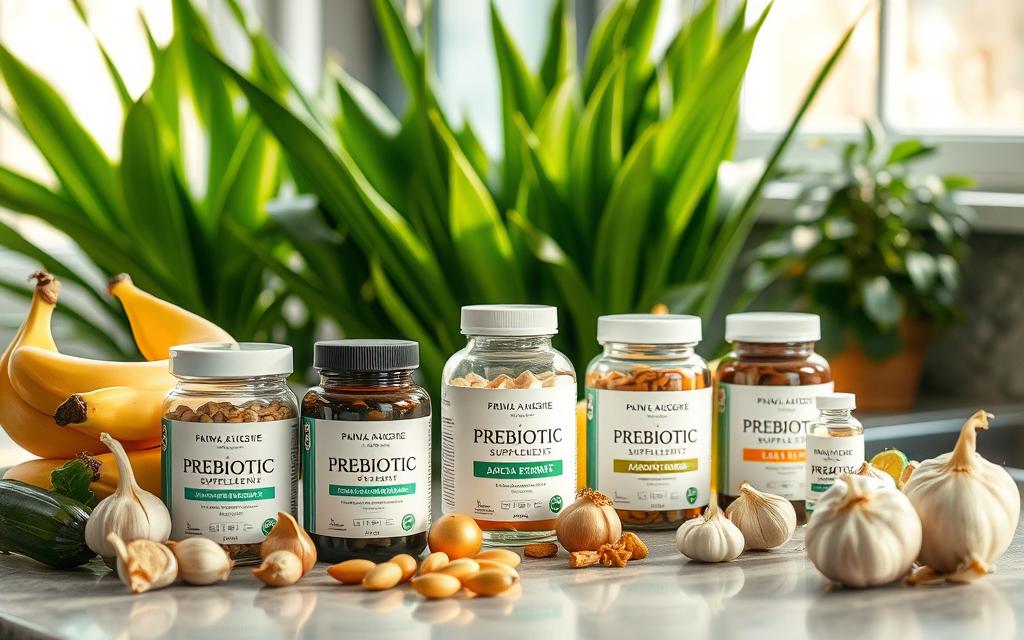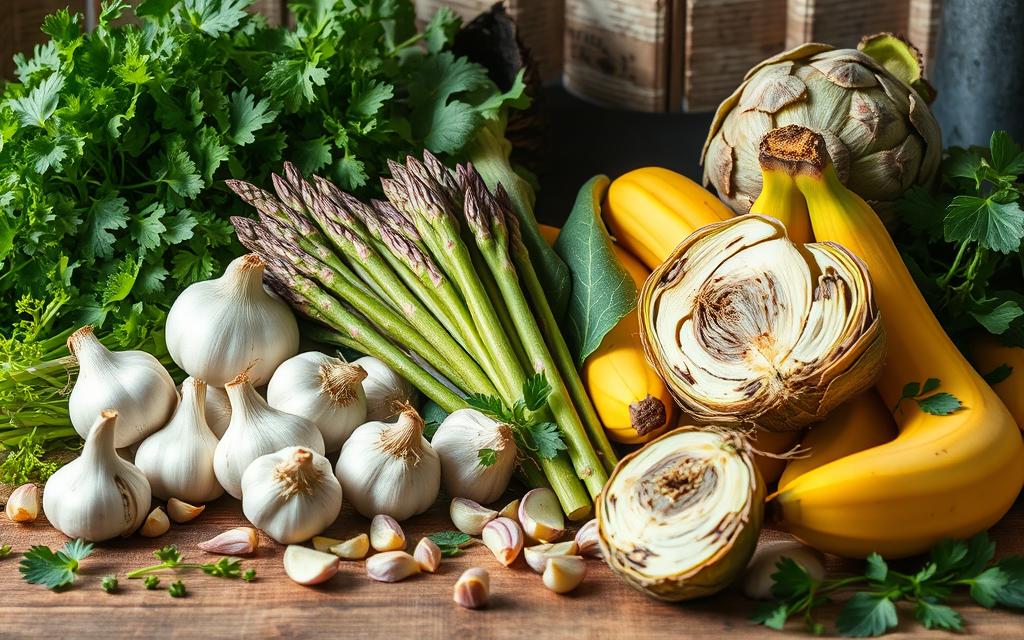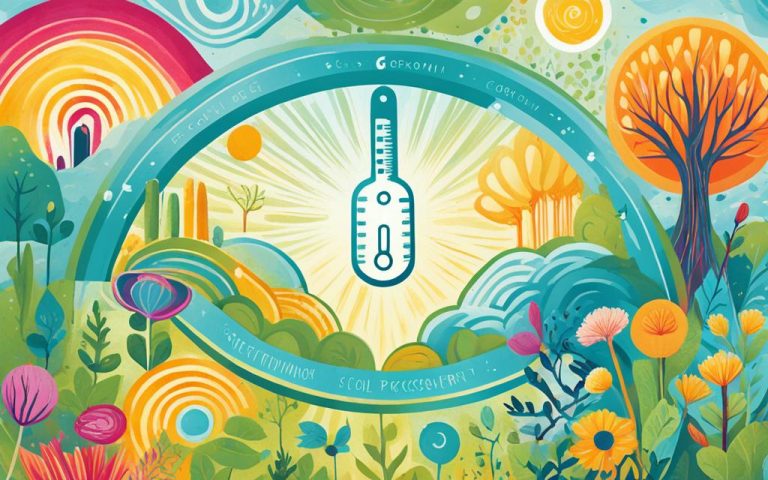Optimize Gut Health with Prebiotic Foods in 2025
Nutrition is always changing, bringing new focus on keeping our guts healthy. Looking into 2025, eating prebiotic foods plays a big part in keeping our digestion strong and our gut bacteria happy. A big discovery was made at the Ri.MED Symposium. It showed how prebiotics help our bodies take in more iron. This finding is a game-changer for health strategies worldwide and for keeping us well1. Danone’s research found that when babies in Kenya ate cereals with a special prebiotic blend, they absorbed 60% more iron. This shows how important prebiotics are for a healthy, tough digestive system as we move into 2025 and beyond.
With 2025’s new studies, people are choosing sustainably sourced ingredients more than ever. This has caused a 210% increase in products with prebiotic claims, grabbing the attention of those who care about their health1. Even so, nine out of ten Americans aren’t eating enough fiber, showing a big problem in our diets12. But, there’s hope. Just one serving of a special fiber equals the fiber in five cups of wheat bran cereal, making it easier to get the fiber we need1.
Key Takeaways
- New research indicates significant advantages of prebiotic-rich diets in improving mineral absorption and digestive health1.
- Sustainably sourced prebiotic ingredients are in high demand by the current generation of eco-conscious consumers1.
- A deficit in daily fiber intake remains a prevalent issue, revealing a critical opportunity for dietary enhancement2.
- Breakthroughs in prebiotic fiber research offer practical solutions to overcome the fiber intake challenge1.
- Accessibility to prebiotic foods with proven health benefits is reshaping consumer choices and gut health dynamics in 20251.
Understanding Prebiotics: What They Are and Why They Matter
Prebiotics play a key part in improving our gut health and overall well-being. We’ll look into what makes prebiotics crucial and how they work with probiotics. This knowledge is important for a healthy life.
Definition of Prebiotics
Prebiotics are special non-digestible fibers. They help the good bacteria in our guts grow strong. These fibers come from foods like wheat, asparagus, garlic, and bananas3. Our body doesn’t digest them, but they’re vital for our gut bacteria.
Differences Between Prebiotics and Probiotics
Probiotics are live bacteria found in supplements and fermented foods. They can boost our health. Prebiotics, however, feed those good bacteria. Together, they help improve our digestion and immune system3.
The Importance of Gut Health
A healthy gut is crucial to our overall health. It helps in digesting food, fighting off sickness, and even in managing our mood. Learning about prebiotics’ benefits is key as interest in gut health grows3.
Some people might have a higher risk of gut health issues. Things like age, smoking, and lack of iron can increase this risk. It’s important to understand these factors3.
Knowing how prebiotics work with our gut is essential. It shows the importance of eating foods rich in prebiotics. Science is always finding out more about how they keep us healthy.
New research helps distinguish prebiotics from other helpful substances. This is exciting for nutrition science. It means we can create better diets focused on prebiotics and other healthful foods.
Recent Research on Prebiotic Foods in 2025
In 2025, studies have made big strides in our understanding of prebiotic foods. We’ve learned more about how these nutrients improve health. Eating foods rich in prebiotics is becoming key for good health.
Key Findings from 2025 Studies
Research in 2025 shows a 13.5% drop in old weight management methods. This is due to new prebiotic formulas4. Also, there’s a rise in supplements that help with weight loss drugs. This indicates a move towards using prebiotics for better digestion and nutrient absorption4. Many people are also trying to understand how prebiotics affect health over time.
Leading Researchers in the Field
Raphaëlle Bourdet-Sicard from Danone Nutricia Research has given vital information on making prebiotics sustainably. Using eco-friendly methods is important and in demand worldwide5.
Implications for Everyday Diet
Adding prebiotics to our diet is now vital. They help with issues like iron deficiency and improve digestion. In 2025, 71% of people focus on eating proteins. They’re also aware of the benefits of prebiotic foods5. Experts believe prebiotics should be part of our daily diet. They help our bodies absorb nutrients better and keep our guts healthy.
Health Benefits of Prebiotic Foods
Diving into the world of prebiotic foods opens up exciting possibilities for health and wellness. Prebiotics help good gut bacteria thrive, key to our health’s foundation.
Recent studies spotlight prebiotics’ role in digestive system regulation. An expert from PharmaNucleus notes the prebiotics market is set to grow significantly between 2024 and 2033. This growth is driven by product innovations improving digestive health, crucial for a balanced gut6.
Improved Digestive Health
Prebiotics are vital for digestive wellness. Research shows inulin-type fructans may boost flu vaccine responses. They highlight prebiotics’ power in supporting our immune system from the digestive angle6.
Additionally, eating prebiotic-rich foods lessens constipation and bloating. This benefit links to the fibers in these foods, aiding in smoother digestion.
Enhanced Immune Response
Prebiotic foods also strengthen the immune system. Studies show they help protect against common viruses, especially in at-risk groups like preterm infants6. This fact highlights prebiotics’ vital role in building a strong immune defense.
Potential Role in Weight Management
Prebiotics play a key part in managing weight too. They affect how the body signals fullness and absorbs nutrients6. Studies suggest they are effective against obesity and diabetes, offering a path to healthier living6.
In summary, the exploration of prebiotic foods reveals their broad impact on health. They not only improve personal health but also aid wider public health goals.
Popular Sources of Prebiotic Foods
More people now understand how important gut health is for overall well-being. This has increased the demand for foods that help the gut, especially those with prebiotics. We will look at different natural sources of prebiotics. These foods are not just common but also very good for keeping a healthy microbiome.
Inulin-Rich Foods
Inulin is a type of dietary fiber that is great for the gut. It is found in chicory root, artichokes, and bananas. Inulin makes the good bacteria in the gut grow7.Products that have inulin, like Organic Agave Inulin from Global Organics, are getting more popular. They don’t just make dairy products healthier by lowering the glycemic index and adding fiber but do so without adding sugar. This makes inulin an ideal choice for people who want healthy and tasty food.
Resistant Starch Sources
- Cooked and cooled potatoes
- Green bananas
- Various legumes
Resistant starch doesn’t break down in the upper digestive tract, making it food for the good bacteria in the colon. The food industry is now focusing on this prebiotic. For example, FibRefine P90 Soluble Tapioca Fiber by Icon Foods is being created. It cuts down on added sugar and supports gut health. This tapioca fiber, from cassava root, will soon be available in an organic format by early 20257.
Other Natural Prebiotic Options
Other natural prebiotics include garlic, onions, and leeks, which have fructooligosaccharides (FOS). Pectin from apples and citrus fruits is also gaining attention. It easily fits into many diets, boosting its prebiotic value7. The trend towards clean, simple, natural ingredients is growing8.
The digestive health market is expanding by 20% each year. Also, 76% of people now see the connection between gut health and overall wellness8. Natural prebiotics like inulin and resistant starch are becoming essential for a healthy diet. They not only improve digestive health but also help achieve overall wellness goals.
How to Easily Incorporate Prebiotics into Your Diet
Improving gut health with diet means knowing how to add prebiotics to your food. Using prebiotics helps your digestion and overall health. It’s especially effective when you mix it with other good stuff like probiotics.
Meal Ideas Featuring Prebiotic Foods
Adding prebiotics to your meals is tasty and healthy. You could mix ingredients like garlic or onions into your stews and soups to add fiber. You can also use foods like cooled potatoes for extra prebiotics in your salads or breakfast7.
Tips for Sourcing Fresh Ingredients
Finding the right ingredients is key to get the most out of prebiotics. Try to get organic stuff, for example, Organic Agave Inulin from the agave plant. It’s great for your metabolism and helps control your blood sugar7. Also, picking fresh, local produce adds more nutrients to your food and is better for the planet.
Balancing Prebiotics with Probiotics
Prebiotics and probiotics work better together. This combo, called synbiotics, improves your gut health a lot. By eating foods like yogurt and kefir, which have both, you can help probiotics survive longer in your gut by up to 50%9. This helps keep your gut healthy and balanced.
| Prebiotic Ingredient | Source | Benefits |
|---|---|---|
| Galactooligosaccharides (GOS) | Dairy | Supports gut health, derived from multiple sources7 |
| FibRefine P90 | Soluble Tapioca Fiber | Reduces sugar, improves mouthfeel in dairy products7 |
| Fructo-oligosaccharides (FOS) | Yogurt | Enhances production of beneficial short-chain fatty acids (SCFAs)9 |
By carefully choosing and planning your meals with prebiotics, you not only help your gut but also improve your overall health. Getting the right balance and quality of prebiotics makes having a healthy gut both doable and fun.
The Role of Fiber in Prebiotic Foods
Dietary fiber is vital in prebiotic foods for gut health. As Americans seek better gut health, knowing the types of fiber and their benefits is key.
Types of Dietary Fiber
- Soluble fiber, which dissolves in water to form a gel-like substance aiding in digestion and nutrient absorption.
- Insoluble fiber, which does not dissolve in water, helping to add bulk to the stool and allowing food to move more quickly through the stomach and intestines.
- Resistant starch, acting as a prebiotic, specifically benefits the gut bacteria, enriching the intestinal microbiome.
Fiber’s Impact on Gut Health
Research shows that eating lots of plants helps maintain a healthy gut microbiome. A study with over 21,000 stool samples found that a veggie-rich diet leads to a vegan-like gut, packed with good bacteria10.
Yet, 95% of Americans don’t get enough fiber for a healthy gut1112.
Recommended Daily Fiber Intake
Women should aim for 25 grams of fiber daily and men 38 grams to feed their gut well. But, most people don’t meet these goals, showing a diet gap.
To easily get more fiber, try products like Fiber Gourmet pasta and Olyra Breakfast Biscuits. They have over 22 grams and 9 grams of fiber per serving, boosting fiber intake11.
| Product | Fiber Content |
|---|---|
| Fiber Gourmet Pasta | 22 grams per serving |
| Olyra Breakfast Biscuits | 9 grams per serving |
Prebiotic Supplements: Are They Worth It?
Prebiotic supplements are becoming more popular in the health market. They range from inulin powders to fructooligosaccharides, aiming to better gut health. It’s vital to know how they work and their benefits before making them a part of your daily health routine.
Overview of Available Supplements
Many supplements claim to boost gut health and overall wellness. One leading product, Benicaros, is well-researched for its positive impact on the gut. It helps produce indole-3-propionic acid (IPA) in various doses. Benicaros highlights how specific prebiotics can improve the gut flora13.
Pros and Cons of Supplementation
Prebiotic supplements are easy to use and have clear benefits. However, it’s important to look at both the good and bad sides. For instance, Benicaros offers solid health perks, like immune support13. But not all supplements have strong evidence of their long-term effects on health. Plus, they might upset the stomach in sensitive individuals. This is why it’s key to talk to a doctor before starting these supplements.
Key Considerations Before Taking Supplements
Before trying prebiotic supplements, think about your diet and health. Some people might not need these supplements if they eat a varied diet14. Also, remember that supplements can cause stomach issues for some. Adjust how much you take to avoid discomfort15.
| Supplement | Primary Ingredient | Efficacy | Common Side Effects |
|---|---|---|---|
| Benicaros | cRG-I (Carrot-derived rhamnogalacturonan-I) | High (Promotes IPA production significantly13) | Minimal (Well-tolerated across diverse gut biomes13) |
| Inulin Supplements | Inulin | Moderate (Supports gut bacteria, can aid weight management15) | Gastrointestinal distress (bloating, gas) |
| Fructooligosaccharides (FOS) | FOS | High (Improves blood sugar levels, reduces cholesterol15) | Bloating, diarrhea (advisable for gradual introduction15) |

When you consider your diet and the effectiveness of supplements, it’s plain to see that prebiotics might be a helpful health boost for some but not all. Choosing to use them should be a personal decision. This decision should factor in your current diet, health, and advice from medical professionals.
Current Trends in Prebiotic Food Products
The prebiotic food market is a mix of new products, health trends, and industry changes. People now choose foods that boost their health for the long run. The industry keeps up by offering fresh and strategic products.
Innovations in the Food Industry
Innovation is key for meeting health-focused consumers’ needs today. The functional foods market is growing fast, expected to hit over $315 billion by 2025. Companies are investing in research to keep up16. New ways to deliver prebiotics, like encapsulation, make them work better and please customers17. Also, global brands are adding organic plant proteins and special whey proteins to their foods. This meets the demand for nutritious, healthful foods16.
Popular Brands Leading the Market
Yakult Pharmaceutical and Beneo lead in prebiotic foods, thanks to smart buys and focus on digestive health prebiotics17. They’re expanding their products to include more prebiotics. They aim to meet customer wants for health benefits and care for the planet.
Consumer Demand for Prebiotic Foods
People want foods that boost digestion, immunity, and overall health. Interest in protein and gut health is growing, partly due to trends like DIY fermentation18. The push towards aging well and sustainable foods also boosts interest in prebiotic foods. Makers need to keep innovating to meet these demands.
For more on how probiotics and prebiotics affect immune and mental health, read The Gut-Brain Revolution article.
Implementation of Prebiotic Foods in Different Diets
Prebiotics are key for gut health in many diets. They fit well in plant-based, Mediterranean, and even in keto and low-carb diets. This shows their flexibility and wide-ranging health advantages. Let’s explore how prebiotics blend into these diets with supporting facts.
Plant-Based Diets
Eating lots of fruits, veggies, legumes, and grains is great for gut health. A study with over 21,000 stool samples from the U.S., U.K., and Italy found that plant foods promote good gut bacteria. These bacteria fight inflammation and boost the immune system19. To improve gut health, include five different plant foods in your diet every day19.
Mediterranean Diet
The Mediterranean diet is full of prebiotic-rich foods like fruits, veggies, nuts, and grains. Research shows that this diet’s plant variety leads to a healthy gut similar to that of vegans and vegetarians19. Eating over 30 types of plant foods a week can improve your gut health19.
Keto and Low-Carb Diets
Keto and low-carb diets reduce carbs but still include prebiotics. Foods like slightly green bananas and cold starchy veggies help keep a good fiber intake. This helps good gut bacteria to thrive, which is vital for health.
Adding prebiotic foods to your diet promotes lasting gut health and well-being.
| Diet Type | Prebiotic Sources | Recommended Intake |
|---|---|---|
| Plant-Based | Vegetables, Legumes, Whole grains, Fruits | 5 different plant-foods per day |
| Mediterranean | Fruits, Vegetables, Nuts, Whole grains | 30 different plant foods per week |
| Keto/Low-Carb | Under-ripe bananas, Cooled starchy vegetables | Moderate, diet-specific |
Potential Risks and Side Effects of Excessive Prebiotic Intake
Prebiotics are key for gut health and our overall well-being. Yet, knowing when it’s too much is important for our diet. Adding too many fibers for gut health must be balanced to avoid discomfort and negative effects.
Digestive Discomfort
High prebiotic intake can sometimes cause stomach upset. Symptoms like bloating, gas, and diarrhea may occur as your gut adjusts. This can be quite uncomfortable, reminding us to watch how much we consume20.
Allergies and Sensitivities
Some people might react badly to certain prebiotics, facing allergies or sensitivities. Prebiotics like inulin can trigger our immune system if taken in large amounts. It’s vital to watch for these signs and adjust our diet to minimize such reactions20.
Finding the Right Balance
It’s important to find a healthy balance with prebiotic intake. Slowly adding these fibers helps our gut microbiota adjust without issues. This approach minimizes side effects and improves our digestive health20.
To sum it up, prebiotics have great health benefits, but we must be cautious with how much we consume. Learning our digestive system’s limits and gradually increasing prebiotics can reduce discomfort. This way, we get the benefits without the drawbacks20.
Understanding Fermented Foods vs. Prebiotic Foods
Fermented foods and prebiotic foods are essential for a healthy gut. They help in different, beneficial ways.
Differences Between Fermented and Prebiotic Foods
Fermented foods are transformed by microorganisms, like bacteria and yeast. They turn sugars into acids and alcohols. This process not only keeps the food good for longer but also adds probiotics. These are good microorganisms that help our health when we eat enough of them. Probiotics are in foods such as certain yogurts and kefirs. A good example is Lactobacillus acidophilus “ABC”21.
Prebiotic foods, on the other hand, have fibers that feed good gut bacteria. They are crucial for merging prebiotics and probiotics together21.
Health Benefits of Fermented Foods
Eating fermented foods brings many health perks. They boost gut health and make the gut more diverse21. This diversity helps reduce inflammation and improves how we digest food. It also helps our bodies better use nutrients like iron and magnesium21. Plus, people have been using fermentation to keep food healthy for a long time22.
Incorporating Both into Your Diet
Knowing how fermented foods and prebiotics work together is key. Including both in your meals offers big health benefits. For instance, eating yogurt with probiotics and a banana with prebiotics helps good gut bacteria grow. This supports not just digestion but overall health too21.
By understanding the unique qualities of fermented and prebiotic foods, we can better support our gut health. A diet that has both encourages a thriving gut ecosystem. This powerful combo plays a big role in maintaining our health21.
The Future of Prebiotic Research
By 2030, prebiotic research will dramatically change many health sectors. This includes gut-brain health and managing chronic conditions. These insights will lead to new diets and treatment methods. They will combine nutrition, microbiology, and the latest technologies.
Trends to Watch in Gut Health Research
Advanced gut health research is on the rise. It harnesses detailed data and innovative ways of study. This progress pairs with growing consumer knowledge and dietary choices, influencing gut health advances. The link between prebiotics and well-being is getting more popular, with a big jump in social media discussions23.
Potential Advances by 2030
Research on prebiotics might unlock new breakthroughs by 2030. The prebiotics market could hit USD 27.75 billion. This would be due to a yearly growth rate of 13.11% from 2024 to 203224. AI will offer customized supplement options, showing the field’s innovation23.
Calls for More Comprehensive Studies
There’s a big demand for deeper prebiotic studies. The goal is to back up promising early results and widen the pool of reliable data. Food and drinks will drive over 82% of the prebiotics market in 2024. There’s a move towards products that are clear, sustainable, and meet health trends and strict rules24.
| Region | 2024 Market Valuation (in billion USD) | Projected Growth 2024-2032 (CAGR) |
|---|---|---|
| Vietnam | Part of Asia Market | 9.2% |
| Japan | Part of Asia Market | 7.8% |
| Singapore | Part of Asia Market | 8.6% |
| Europe | Integral Part of Global Market | 8.1% |
Government Guidelines on Fiber and Prebiotics
Following government dietary advice helps people get the right balance of nutrients for good health. Health organizations stress eating enough fiber. This is key now, as our food choices keep changing.
Recommended Intakes by Health Organizations
Health groups play a big role in setting fiber levels we should eat each day. They show us how eating more fiber can stop many health problems. Just 10 more grams of fiber daily could mean a 20% lower risk of heart issues25.
Even with these facts, most people only eat about 17 grams of fiber each day. That’s less than the suggested 22–34 grams25.
Understanding Your Dietary Needs
These guidelines aim to help everyone, including doctors, focus on fiber and prebiotics. They adapt general advice to meet personal health needs and diets.
Resources for More Information
There are also many tools and articles available from health organizations. These offer deep insights into prebiotics. They help both the public and health experts learn the value of a diet rich in fiber.
| Food Item | Importance | Increase in Consumer Interest |
|---|---|---|
| High-Protein Yogurt | High in protein, supports gut health | Rising popularity26 |
| Cottage Cheese | Rich in protein and prebiotics | Rising market consumption26 |
| Functional Mocktails | Alternative to alcoholic beverages with health benefits | Increasing interest in healthier drink options26 |
Personal Stories: Experiences with Prebiotic Foods
More and more people are seeing the value of prebiotic foods in their diets. These personal stories show us how important healthy eating is. They reveal the real-world effects of prebiotics on both regular folks and health experts.
Testimonials from Integrative Health Practitioners
Health professionals have seen big changes when using prebiotics. For people with IBS, eating foods rich in prebiotics has made their gut health better. This is because it boosts good bacteria that they usually lack27. Plus, patients eating a variety of plant foods daily have a healthier gut thanks to a more diverse range of bacteria27.
Real-Life Benefits Shared by Consumers
People who eat prebiotic foods share exciting improvements. Some say that adding prebiotic-rich drinks to their meals has boosted their digestion and overall health. This helps them meet their fiber needs every day27. Others have seen their gut bacteria improve after eating foods like white navy beans, reducing bad bacteria28.
Case Studies Worth Noting
In specific cases like IBS-C, using inulin-type fructans has been effective. Yet, it sometimes causes more gas27. Another study showed that prebiotics alone didn’t ease IBS symptoms much. But, they were key in managing the condition by balancing gut bacteria27.
| Prebiotic Intervention | Health Outcome | Study Findings |
|---|---|---|
| Inulin-type fructans | Beneficial for IBS-C | Improves digestion but may increase flatulence27 |
| White navy beans | Enhanced gut microbiota | Decrease in harmful bacteria after daily inclusion28 |
| General prebiotic-rich diet | Diverse gut microbiota | Incorporating multiple plant sources enhances gut health27 |
| High-fiber prebiotic beverages | Improved digestion | Significant contribution to daily fiber intake27 |
From clinical evidence to personal journeys, these stories show the deep impact of prebiotics on health. They do more than just manage illness—they improve daily well-being. Such insights inspire us to embrace prebiotics for a better life.
Conclusion: Taking Steps Towards a Healthier Gut
Recent studies in 2025 show prebiotics are key for better gut health. It’s important to eat 30 grams of fiber daily, but many folks find this hard29. Drinking two to three liters of water a day helps our gut flora work well29. Personalized eating plans work better than the same diet for everyone, showing we need to eat based on our own gut needs.
Adding prebiotics from foods like onions, garlic, and leeks is vital for good bacteria29. Cutting back on sugar and alcohol is crucial, as too much can upset our stomachs, leading to bloating and gas29. New technologies, like Humiome® B2, are being developed to help our gut health with specific nutrients30.
Getting enough sleep and eating fermented foods help keep our gut healthy, especially if we’ve eaten too much junk food29. This balanced approach shows how a good gut health plan should include personalized science and habits. By following these tips, eating well, and understanding our gut’s role in health, we head towards a healthier life.
FAQ
What are prebiotic foods, and how do they impact gut health?
Prebiotic foods are made up of carbs that our bodies can’t digest. These carbs feed the good bacteria in our guts. Eating these foods helps keep our digestive system healthy and improves our overall health. Studies in 2025 show that prebiotic foods are crucial for a healthy gut.
How do prebiotics differ from probiotics?
Prebiotics are fibers that help good bacteria grow in the gut. Probiotics are the actual good bacteria. Both are essential for our gut health, but they work in different ways.
What are the latest scientific developments regarding prebiotic foods?
In 2025, new studies have shown that prebiotic foods can help our bodies absorb more nutrients. For instance, research from Danone Nutricia Research found that certain prebiotic foods increase iron absorption. This shows how prebiotics directly boost our health and nutrition.
Can you list some health benefits of prebiotic foods?
Sure! Prebiotic foods help make our digestive system healthier and balance our gut bacteria. They also make our immune system stronger. Plus, they might help control our weight by affecting how we absorb nutrients and how full we feel.
What are some examples of foods rich in prebiotics?
For prebiotics, think chicory root, artichokes, and bananas because they have a lot of inulin. Grains, seeds, and legumes are packed with resistant starch. These foods feed the good bacteria in our guts.
What are some tips for including prebiotics in my diet?
To add more prebiotics to your meals, use garlic and onions in dishes like stews and soups. You can also add cooked and cooled potatoes to salads for resistant starch. Combining prebiotics and probiotics can give your gut health an extra boost.
What is the role of dietary fiber in prebiotic foods?
Fibers like inulin and certain oligosaccharides are essential for feeding good gut bacteria. It’s important to meet the daily fiber intake recommended nationally to get all the benefits from prebiotics.
Should I consider taking prebiotic supplements?
Prebiotic supplements, like inulin powders, can be a convenient way to get your prebiotics, especially if you have dietary restrictions. But it’s best to talk to a healthcare pro to see if they’re right for you.
What are the current trends in prebiotic food products?
The demand for prebiotic foods is growing, with more products coming out. These products often contain prebiotic ingredients that are scientifically proven, sustainable, and gentle on the stomach, appealing to health-conscious shoppers.
How can prebiotic foods be integrated into various dietary regimens?
Prebiotic foods like veggies, legumes, and whole grains are key in diets like the plant-based and Mediterranean diets. Even if you’re on a keto or low-carb diet, you can still include prebiotics by choosing foods that fit your macronutrient needs.
Are there any risks associated with consuming too many prebiotic foods?
Although prebiotic foods are healthy, eating too much can cause discomfort like bloating and gas. Some people might also be sensitive to certain prebiotic fibers. So, it’s a good idea to increase these foods slowly in your diet.
How do fermented foods complement prebiotic foods in supporting gut health?
Fermented foods add live cultures to the gut, enhancing its microbial diversity. Prebiotic foods feed these bacteria. Eating both kinds can make your gut healthier and improve your overall well-being.
What is the future outlook for prebiotic research?
Future research on prebiotics will focus more on how they affect gut health and the brain. This could change dietary guidelines and how we treat some illnesses.
Where can I find recommended fiber intake guidelines from health organizations?
Organizations like the USDA share guidelines on how much fiber we should eat daily. This helps us keep our gut healthy. You can find these guidelines on their websites or through nutrition education resources.
Why are personal stories and experiences with prebiotic foods important?
Stories from people and experts show the real-life benefits of prebiotic foods on health. They can help others see the value of prebiotics in improving well-being.
What are the key takeaways from recent prebiotic foods research?
Recent studies highlight the need to customize our diets based on personal health and dietary goals. They show prebiotic foods are good for our digestion and suggest eating according to our unique nutritional needs.
Source Links
- https://www.foodnavigator-usa.com/News/Promotional-features/arrabina-prebiotic-dietary-fibers-for-gut-health/
- https://www.simonstapleton.com/20-scientifically-proven-weight-loss-strategies-for-2025/
- https://www.mdpi.com/2076-2607/13/1/57
- https://www.nutritionaloutlook.com/view/2025-nutraceutical-and-natural-product-industry-outlook-insights-from-nutritional-outlook-s-editorial-advisory-board
- https://www.nutraceuticalsworld.com/breaking-news/frieslandcampina-spotlights-nutrition-trends-for-2025/
- https://www.dsm-firmenich.com/en/businesses/health-nutrition-care/news/talking-nutrition/how-can-prebiotic-ingredients-provide-holistic-health-benefits-through-the-gut-microbiome.html
- https://www.dairyfoods.com/articles/97859-ingredient-suppliers-highlight-the-latest-innovations-for-pre-post-and-probiotics
- https://www.bakeryandsnacks.com/Article/2025/01/10/top-10-health-driven-trends-shaping-bakery-and-snacks-in-2025/
- https://layerorigin.com/blogs/blog-layer-origin-nutrition/why-adding-prebiotics-to-yogurt-or-kefir-is-the-best-way-to-consume-them?srsltid=AfmBOooFC1x2NQJFacrJqV1gbRAmrF9S6lihFBDB7OZnBXY5RmbYc9Up
- https://www.npr.org/sections/shots-health-news/2025/01/10/nx-s1-5254349/gut-health-microbiome-vegan-vegetarian-omnivore
- https://vocal.media/families/9-food-trends-that-dietitians-will-be-keeping-an-eye-on-in-2025
- https://www.yahoo.com/lifestyle/9-food-trends-dietitians-watching-095500866.html
- https://www.nutritionaloutlook.com/view/carrot-derived-prebiotic-enhances-gut-microbiome-function-according-to-study
- https://medium.com/illumination/the-power-of-probiotics-and-prebiotics-unlocking-a-healthier-gut-and-body-995c6501c48c
- https://trybellie.com/blogs/blogs/best-prebiotic-supplement-guide
- https://www.thebusinessresearchcompany.com/report/functional-foods-global-market-report
- https://www.openpr.com/news/3810631/food-grade-prebiotics-market-generated-opportunities-future
- https://asiafoodjournal.com/frieslandcampina-ingredients-reveals-key-nutrition-trends-2025/
- https://thepublicsradio.org/npr/hey-meat-eaters-your-gut-health-can-rival-a-vegans-heres-how/
- https://medwinpublishers.com/MJCCS/everything-about-the-prebiotics-and-probiotics-and-their-effect-on–public-health.pdf
- https://www.thelifestyledietitian.com.au/blog/are-all-fermented-foods-probiotics-what-you-need-to-know
- https://www.mdpi.com/2304-8158/14/1/114
- https://international-dairy.com/news/home/revealing-key-nutrition-trends-for-2025/
- https://www.openpr.com/news/3808376/prebiotics-market-poised-for-rapid-growth-projected-to-reach
- https://foodandnutrition.com/top-10-food-and-nutrition-trends-for-2025/
- https://www.aol.com/experts-reveal-biggest-nutrition-trends-122300754.html
- https://www.signos.com/blog/can-prebiotic-sodas-worsen-ibs-symptoms
- https://www.mdanderson.org/cancerwise/11-new-research-advances-from-the-past-year.h00-159703068.html
- https://www.gloucestershirelive.co.uk/news/health/im-nutritionist-six-things-reset-9842355
- https://www.dsm-firmenich.com/en/businesses/health-nutrition-care/news/talking-nutrition/new-gut-health-research-for-humiome-b2.html







